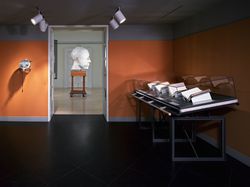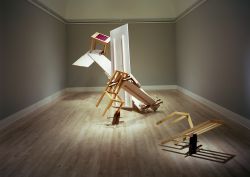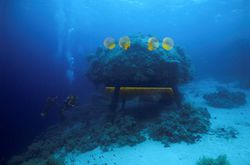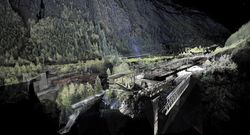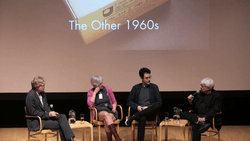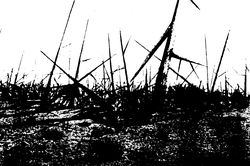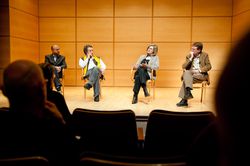Piero en tête présente des sculptures contemporaines de l’artiste canado-britannique Geoffrey Smedley, ainsi que 30 livres rares datant du XVe au XVIIIe siècle. Les sculptures de Smedley s’inspirent d’une série de dessins de tête humaine, réalisés par le maître de la Renaissance Piero della Francesca. L’exposition relie ces dessins et les sculptures de Smedley à la(...)
Salle octogonale
2 mai 2001 au 16 septembre 2001
Piero en tête
Actions:
Description:
Piero en tête présente des sculptures contemporaines de l’artiste canado-britannique Geoffrey Smedley, ainsi que 30 livres rares datant du XVe au XVIIIe siècle. Les sculptures de Smedley s’inspirent d’une série de dessins de tête humaine, réalisés par le maître de la Renaissance Piero della Francesca. L’exposition relie ces dessins et les sculptures de Smedley à la(...)
Salle octogonale
Paraboles et autres allégories : L’Œuvre de Melvin Charney 1975-1990 présente une centaine de dessins, dont plusieurs à grande échelle, des esquisses, des photographies, ainsi que trois grandes constructions. Réunissant des pièces issues de diverses collections publiques et privées, dont celle du CCA, l’exposition permet une analyse globale de la démarche artistique de(...)
Salles principales
9 octobre 1991 au 12 janvier 1992
Paraboles et autres allégories : L'oeuvre de Melvin Charney, 1975-1990
Actions:
Description:
Paraboles et autres allégories : L’Œuvre de Melvin Charney 1975-1990 présente une centaine de dessins, dont plusieurs à grande échelle, des esquisses, des photographies, ainsi que trois grandes constructions. Réunissant des pièces issues de diverses collections publiques et privées, dont celle du CCA, l’exposition permet une analyse globale de la démarche artistique de(...)
Salles principales
Isola et Norzi : Conshelf II
Les artistes Hilario Isola et Matteo Norzi parlent de la base sous-marine Précontinent II de Jacques Cousteau et de leur propre projet Liquid Door qui propose de réanimer le rêve d’une vie sous-marine en rendant la maison « Étoile de mer » de Cousteau habitable. Basés à New York, les Italiens Hilario Isola et Matteo Norzi collaborent depuis 2003, mettant en commun leurs(...)
Théâtre Paul-Desmarais
13 mai 2010 , 19h
Isola et Norzi : Conshelf II
Actions:
Description:
Les artistes Hilario Isola et Matteo Norzi parlent de la base sous-marine Précontinent II de Jacques Cousteau et de leur propre projet Liquid Door qui propose de réanimer le rêve d’une vie sous-marine en rendant la maison « Étoile de mer » de Cousteau habitable. Basés à New York, les Italiens Hilario Isola et Matteo Norzi collaborent depuis 2003, mettant en commun leurs(...)
Théâtre Paul-Desmarais
Dénouer le paysage numérique
Dans cette conférence, Christophe Girot aborde les modèles de paysage numérique : Le design et l’analyse du paysage numérique ont traversé une révolution tranquille au cours des dix dernières années, suscitée par l’introduction de modèles numériques de nuages de points. La portée et la précision de ces modèles de paysages numériques créés à l’aide de lecteurs laser(...)
Théâtre Paul-Desmarais
6 octobre 2016, 18h
Dénouer le paysage numérique
Actions:
Description:
Dans cette conférence, Christophe Girot aborde les modèles de paysage numérique : Le design et l’analyse du paysage numérique ont traversé une révolution tranquille au cours des dix dernières années, suscitée par l’introduction de modèles numériques de nuages de points. La portée et la précision de ces modèles de paysages numériques créés à l’aide de lecteurs laser(...)
Théâtre Paul-Desmarais
Sous-série
Opera Houses
CI001.S2.D3
Description:
Charles Rohault de Fleury's sustained involvement with the design of opera houses began with his appointment in 1846 as official architect of the existing Salle Le Pelletier, home to the *Paris Opera, and continued until an open competition was called in 1860 (Charles Garnier won this competition). During this period Rohault de Fleury submitted numerous proposals to replace theprovisional Salle Le Pelletier with a structure more appropriate to the grandeur and importance of France's national opera company. The CCA collection contains four projects related to his work for the Paris opera: two early projects (1846 and 1847) and one later one (1859) for a newopera house, and a portfolio of lithographs and drawings related to alterations and repairs to Salle Le Pelletier (1850-1854). The collection also includes Charles' earliest theatre project, a comprehensive plan for an opera house and surrounding infrastructure for the Theatre Royal Italien opera company (1838-1840), and an album containing drawings and prints of antique and contemporary theatres (1839-1854?). Charles' first project was for the Theatre Royal Italien opera company whose previous home, the Salle Favart, had burned down on the night of January 14 1838. The CCA collection contains an album of presentation drawings for a new theatre located on rue de la Paix with boutiques in the adjacent 'passages' (DR1974:0002:019:001-023). A second album consists of site plans including proposed 'maisons à loyers' (apartment buildings) and documents relating to the cost estimates and rental income for the entire project (DR1974:0002:036:001-016). The architectural style and interior arrangement of the theatre is heavily indebted to Francois Debret's Salle Le Pelletier. Charles' originality lies more in his conception of the social and economic role of the theatre in relation and integration, to its surrounding urban fabric. An explanation of the entire Theatre Royal Italien project, and Charles' role as architect in it, is found in two proposal letters (located in the Avery Library, Columbia University, NY) written by the entrepreneur Eugene Lecomte to the Minister of the Interior, Comte Duchatel, on May 15 and October 31 1839 (1). Charles' album of drawings at the CCA for the theatre and some of the cost and rental estimates are probably presentation copies directly related to the first letter, and most likely submitted to the Minister of the Interior. Charles' project was never executed, and the Italian opera company eventualy found a permanent home in the existing Salle Ventadour (1841). However, the inclusive nature of the Théâtre Royal Italien proposal, with its stress on urban development and contextuality, continued to play a seminal role in his later Paris Opera projects. Upon replacing Francois Debret as architect of Salle Le Pelletier in 1846, Charles proposed nine possible locations (site plans) for a new opera house for the Paris Opera (*Academie Royale de Musique) and, in the following year (1847) prepared a portfolio of drawings for the actual structure with an accompanying seven-page manuscript describing the project. Although executed in successive years, the site plans and 1847 drawings are conceptually related. Both components were undertaken in response to offical interest in a public competition that was never implemented (2)(3). The CCA has two sets of the nine site plans proposed in 1846 (DR1974:0002:036:001-016), one containing transfer lithographed site plans with a written analysis and cost estimate for each of the proposed locations, and the other with only the site plans (similar sets are located in the 'Archives Nationales' in France). They indicate that Charles, (heavily influenced by his Théâtre Royal Italien project) preferred the Rue de la Paix location (siteplan #3) for the new opera house. Although site plan number six, Boulevard des Capucines, was not favoured at this date, it is highly prophetic as it was the location officially chosen in 1860 for the new opera house. Apparently unique to the CCA collection is the 1847 manuscript and portfolio of drawings for the proposed opera house (DR1974:0002:036:001-016). The manuscript is both an indepth review of the requirements for a national opera house and a guide to his portfolio of drawings. Charles' conception and design continued to be strongly influenced by Debret's Salle Lepelletier, as well as his own Théâtre Italien project, and various antique and contemporary opera houses and theatres. Many of the French and Italian sources mentioned in the manuscript are collected in an album (DR1974:0002:010:001-048) as references for his own designs (4). As official architect of Salle Le pelletier, Charles was also responsible for repairs, restorations, and alterations to the existing structure. The drawings and transfer lithographs in the CCA collection (DR1974:0002:036:001-016) are primarily dated 1854, and relate to documented repair and restoration projects undertaken during this period (5)(6). The CCA collection has the presentation drawings and lithographs for the later 1859 project (DR1974:0002:027:001-027) for the Paris opera (*Theatre Imperiale de l'opera) that were sent to Achille Fould, the Minister of State. This project is probably a counterpart to a similiar one that he submitted to the Prefect of the Seine, Baron Haussmann, in the same year (7). Site plans show the opera house on an irregular polygonal site facing Boulevard des Capucines. The placement of the 'maisons à loyers' on the rear of the site reflects Charles' continued emphasis on integrating his opera projects into the surrounding urban context. In 1859, it appeared that Charles was favoured to build the new opera house. But late in the following year, a public competition was called in which Charles Garnier emerged as the victor. Although Charles did not build the final structure, his numerous projects, as exemplified in the CCA collection, were of prime importance in determining the location, configuration, and plan of the Place de l'Opera (8). * The 'Paris Opera' was France's national opera, and thus its name changed numerous times throughout its history according to altering perceptions of its role in French culture and/or changes in political regimes. For reasons of clarity, the national opera will be referred to as the Paris Opera. The names indicated in brackets with a star refer to the proper name of the opera company at the date of the project. (1) Eugene Le Comte, "Projet de Salle rue de la Paix, pour le Théâtre Royal Italien: Lettres à Monsieur le Ministre de l'Intérieur, en date des 15 mai et 31octobre 1839" (Paris: P. Dupont, 1839). (2) Christopher Curtis Mead, "Charles Garnier's Paris Opera and the Renaissance of Classicism in Nineteenth century French Architecture", 3 vols. (PhD thesis; Philadelphia: University of Pennsylvania, 1986), p. 234 and p. 956, fn. 30. (3) Monika Steinhauser, "Die Architektur des Pariser Oper" (Munich: Prestel Verlag, 1969), p. 45, fns. 143 and 144. (4) Barry Bergdoll, "Charles Rohault de Fleury: Part Three: Theatres and the Opera house", 'CCA Research Report', n.d., p. 3. (5) Larousse XIXth Century, s.v. "Rohault de Fleury, Charles". (6) Mead, p. 238. (7) Oeuvres de C. Rohault de Fleury, architecte" (Paris: Librarie centrale d'architecture, 1884).. (8) Macmillan, s.v. "Rohault de Fleury Familly".
1717-1868
Opera Houses
CI001.S2.D3
Description:
Charles Rohault de Fleury's sustained involvement with the design of opera houses began with his appointment in 1846 as official architect of the existing Salle Le Pelletier, home to the *Paris Opera, and continued until an open competition was called in 1860 (Charles Garnier won this competition). During this period Rohault de Fleury submitted numerous proposals to replace theprovisional Salle Le Pelletier with a structure more appropriate to the grandeur and importance of France's national opera company. The CCA collection contains four projects related to his work for the Paris opera: two early projects (1846 and 1847) and one later one (1859) for a newopera house, and a portfolio of lithographs and drawings related to alterations and repairs to Salle Le Pelletier (1850-1854). The collection also includes Charles' earliest theatre project, a comprehensive plan for an opera house and surrounding infrastructure for the Theatre Royal Italien opera company (1838-1840), and an album containing drawings and prints of antique and contemporary theatres (1839-1854?). Charles' first project was for the Theatre Royal Italien opera company whose previous home, the Salle Favart, had burned down on the night of January 14 1838. The CCA collection contains an album of presentation drawings for a new theatre located on rue de la Paix with boutiques in the adjacent 'passages' (DR1974:0002:019:001-023). A second album consists of site plans including proposed 'maisons à loyers' (apartment buildings) and documents relating to the cost estimates and rental income for the entire project (DR1974:0002:036:001-016). The architectural style and interior arrangement of the theatre is heavily indebted to Francois Debret's Salle Le Pelletier. Charles' originality lies more in his conception of the social and economic role of the theatre in relation and integration, to its surrounding urban fabric. An explanation of the entire Theatre Royal Italien project, and Charles' role as architect in it, is found in two proposal letters (located in the Avery Library, Columbia University, NY) written by the entrepreneur Eugene Lecomte to the Minister of the Interior, Comte Duchatel, on May 15 and October 31 1839 (1). Charles' album of drawings at the CCA for the theatre and some of the cost and rental estimates are probably presentation copies directly related to the first letter, and most likely submitted to the Minister of the Interior. Charles' project was never executed, and the Italian opera company eventualy found a permanent home in the existing Salle Ventadour (1841). However, the inclusive nature of the Théâtre Royal Italien proposal, with its stress on urban development and contextuality, continued to play a seminal role in his later Paris Opera projects. Upon replacing Francois Debret as architect of Salle Le Pelletier in 1846, Charles proposed nine possible locations (site plans) for a new opera house for the Paris Opera (*Academie Royale de Musique) and, in the following year (1847) prepared a portfolio of drawings for the actual structure with an accompanying seven-page manuscript describing the project. Although executed in successive years, the site plans and 1847 drawings are conceptually related. Both components were undertaken in response to offical interest in a public competition that was never implemented (2)(3). The CCA has two sets of the nine site plans proposed in 1846 (DR1974:0002:036:001-016), one containing transfer lithographed site plans with a written analysis and cost estimate for each of the proposed locations, and the other with only the site plans (similar sets are located in the 'Archives Nationales' in France). They indicate that Charles, (heavily influenced by his Théâtre Royal Italien project) preferred the Rue de la Paix location (siteplan #3) for the new opera house. Although site plan number six, Boulevard des Capucines, was not favoured at this date, it is highly prophetic as it was the location officially chosen in 1860 for the new opera house. Apparently unique to the CCA collection is the 1847 manuscript and portfolio of drawings for the proposed opera house (DR1974:0002:036:001-016). The manuscript is both an indepth review of the requirements for a national opera house and a guide to his portfolio of drawings. Charles' conception and design continued to be strongly influenced by Debret's Salle Lepelletier, as well as his own Théâtre Italien project, and various antique and contemporary opera houses and theatres. Many of the French and Italian sources mentioned in the manuscript are collected in an album (DR1974:0002:010:001-048) as references for his own designs (4). As official architect of Salle Le pelletier, Charles was also responsible for repairs, restorations, and alterations to the existing structure. The drawings and transfer lithographs in the CCA collection (DR1974:0002:036:001-016) are primarily dated 1854, and relate to documented repair and restoration projects undertaken during this period (5)(6). The CCA collection has the presentation drawings and lithographs for the later 1859 project (DR1974:0002:027:001-027) for the Paris opera (*Theatre Imperiale de l'opera) that were sent to Achille Fould, the Minister of State. This project is probably a counterpart to a similiar one that he submitted to the Prefect of the Seine, Baron Haussmann, in the same year (7). Site plans show the opera house on an irregular polygonal site facing Boulevard des Capucines. The placement of the 'maisons à loyers' on the rear of the site reflects Charles' continued emphasis on integrating his opera projects into the surrounding urban context. In 1859, it appeared that Charles was favoured to build the new opera house. But late in the following year, a public competition was called in which Charles Garnier emerged as the victor. Although Charles did not build the final structure, his numerous projects, as exemplified in the CCA collection, were of prime importance in determining the location, configuration, and plan of the Place de l'Opera (8). * The 'Paris Opera' was France's national opera, and thus its name changed numerous times throughout its history according to altering perceptions of its role in French culture and/or changes in political regimes. For reasons of clarity, the national opera will be referred to as the Paris Opera. The names indicated in brackets with a star refer to the proper name of the opera company at the date of the project. (1) Eugene Le Comte, "Projet de Salle rue de la Paix, pour le Théâtre Royal Italien: Lettres à Monsieur le Ministre de l'Intérieur, en date des 15 mai et 31octobre 1839" (Paris: P. Dupont, 1839). (2) Christopher Curtis Mead, "Charles Garnier's Paris Opera and the Renaissance of Classicism in Nineteenth century French Architecture", 3 vols. (PhD thesis; Philadelphia: University of Pennsylvania, 1986), p. 234 and p. 956, fn. 30. (3) Monika Steinhauser, "Die Architektur des Pariser Oper" (Munich: Prestel Verlag, 1969), p. 45, fns. 143 and 144. (4) Barry Bergdoll, "Charles Rohault de Fleury: Part Three: Theatres and the Opera house", 'CCA Research Report', n.d., p. 3. (5) Larousse XIXth Century, s.v. "Rohault de Fleury, Charles". (6) Mead, p. 238. (7) Oeuvres de C. Rohault de Fleury, architecte" (Paris: Librarie centrale d'architecture, 1884).. (8) Macmillan, s.v. "Rohault de Fleury Familly".
File 3
1717-1868
Olumuyiwa Adegun, chercheur en résidence 2016, présente ses recherches : Les villes d’Europe au XIXe siècle, à l’instar des villes d’Afrique aujourd’hui, ont souffert de graves problèmes de logement. Les bidonvilles ont marqué Berlin et Paris, tout comme dans les dernières décennies, le logement informel est devenu un trait particulier de Nairobi et de Johannesburg.(...)
Maison Shaughnessy
4 août 2016, 18h
Séminaire de chercheur en résidence : Olumuyiwa Adegun
Actions:
Description:
Olumuyiwa Adegun, chercheur en résidence 2016, présente ses recherches : Les villes d’Europe au XIXe siècle, à l’instar des villes d’Afrique aujourd’hui, ont souffert de graves problèmes de logement. Les bidonvilles ont marqué Berlin et Paris, tout comme dans les dernières décennies, le logement informel est devenu un trait particulier de Nairobi et de Johannesburg.(...)
Maison Shaughnessy
Le début des années 1950 donne lieu à de grands bouleversements mondiaux. De l’Inde au Maroc, du Guatemala à l’Indochine, la décolonisation s’accélère et la Guerre froide s’amorce. Les architectes qui travaillent ou interviennent à titre d’experts dans des régions non occidentales ne peuvent plus penser les lieux comme s’il s’agissait de terrains vagues aménagés pour des(...)
Salles principales Mot(s)-clé(s):
Casablanca, Chandigarh, Le Corbusier, Jeanneret, Morocco, Pendab, Inde, modernism, Africa, Takashi Homma, Yto Barrada, Maroc
26 novembre 2013 au 20 avril 2014
Comment les architectes, les experts, les politiciens, les agences internationales et les citoyens négocient l'urbanisme moderne : Casablanca Chandigarh
Actions:
Description:
Le début des années 1950 donne lieu à de grands bouleversements mondiaux. De l’Inde au Maroc, du Guatemala à l’Indochine, la décolonisation s’accélère et la Guerre froide s’amorce. Les architectes qui travaillent ou interviennent à titre d’experts dans des régions non occidentales ne peuvent plus penser les lieux comme s’il s’agissait de terrains vagues aménagés pour des(...)
Salles principales Mot(s)-clé(s):
Casablanca, Chandigarh, Le Corbusier, Jeanneret, Morocco, Pendab, Inde, modernism, Africa, Takashi Homma, Yto Barrada, Maroc
Peter Galison, professeur Joseph Pellegrino d’histoire des sciences et de physique à l’Université Harvard, parle de son projet actuel, qui combine écriture et film sur les sites de déchets nucléaires et l’avenir des territoires. « Dans leur acception habituelle, les termes “décharge” et “étendue sauvage” sont antinomiques; lorsqu’ils se rejoignent sur les sites abritant(...)
Librairie du CCA
14 février 2010 , 15h
Peter Galison : Étendue sauvage de déchets
Actions:
Description:
Peter Galison, professeur Joseph Pellegrino d’histoire des sciences et de physique à l’Université Harvard, parle de son projet actuel, qui combine écriture et film sur les sites de déchets nucléaires et l’avenir des territoires. « Dans leur acception habituelle, les termes “décharge” et “étendue sauvage” sont antinomiques; lorsqu’ils se rejoignent sur les sites abritant(...)
Librairie du CCA
La pratique muséologique, telle qu’elle a émergé au cours du XXe siècle, est sans contredit profondément remaniée. Les changements radicaux dans le statut de l’objet, de la culture, des diverses disciplines ou de l’information et de l’éducation entraînent une inévitable transformation du rôle et des compétences du conservateur. Un intérêt renouvelé pour la pratique(...)
Théâtre Paul-Desmarais
11 novembre 2010 au 13 novembre 2010
Le CCA dans un champ muséologique en expansion
Actions:
Description:
La pratique muséologique, telle qu’elle a émergé au cours du XXe siècle, est sans contredit profondément remaniée. Les changements radicaux dans le statut de l’objet, de la culture, des diverses disciplines ou de l’information et de l’éducation entraînent une inévitable transformation du rôle et des compétences du conservateur. Un intérêt renouvelé pour la pratique(...)
Théâtre Paul-Desmarais
